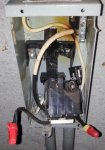Greg Swartz
Senior Member
- Location
- Colorado Springs, Colorado
Ok,
I just got a call from the Hot Tub company we work with all the time...
Most of their hot tubs use a 20A / 30A split system. Each breaker is a GFCI breaker.
Apparently, today, they went to service one of their tubs, and the "electrician buddy" who hooked up the tub (without a permit) used a regular 20A and 30A breaker, but put a 50A GFCI breaker in the main panel.
They asked me if this is OK.
Part of me says "yes." Part of me is screaming "NO!"
Why yes?
Well, electrically, putting the GFCI upstream should be no different than having 2 individual GFCI breakers.
Why no?
I really don't know...
I know the manufacturer will not warranty it, and that it does not follow manufacturer guidelines. But other than that???
Give me some feedback please! :?
I just got a call from the Hot Tub company we work with all the time...
Most of their hot tubs use a 20A / 30A split system. Each breaker is a GFCI breaker.
Apparently, today, they went to service one of their tubs, and the "electrician buddy" who hooked up the tub (without a permit) used a regular 20A and 30A breaker, but put a 50A GFCI breaker in the main panel.
They asked me if this is OK.
Part of me says "yes." Part of me is screaming "NO!"
Why yes?
Well, electrically, putting the GFCI upstream should be no different than having 2 individual GFCI breakers.
Why no?
I really don't know...
I know the manufacturer will not warranty it, and that it does not follow manufacturer guidelines. But other than that???
Give me some feedback please! :?



